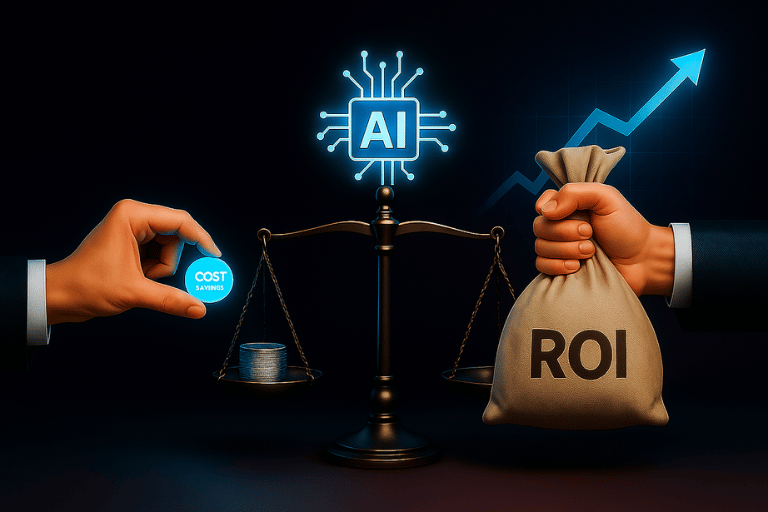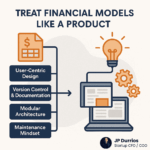The AI vendor landscape is burgeoning, with so many interesting use cases and applications. Yet, it’s all still very new and, in the case of many vendors, the ROI is still unproven despite all the marketing. We’re getting there, but we’ve seen a few cases of misfires in the news lately, e.g. Klarna and others.
It reminds me of when cloud computing started to gain momentum and everyone jumped on the bandwagon, to realize a few quarters later that their hosting costs were growing faster than revenue. Cloud computing was definitely the future, like AI is today, but too many companies rushed to follow a trend with the simplistic aspiration of cost reduction, and not having enough alignment behind the “why” to do it right. It feels very much the same today with AI 🙂
We’re seeing two patterns emerging:
- On one hand, a growing number of companies are using AI/automation to reduce inefficiencies and cut costs. In some instances, those make sense, as the post-COVID exuberances had to finally meet reality.
- In stark contrast, another group of companies sees AI as a multiplier, an asset capable of amplifying human capabilities, unlocking innovation, and thus profitable growth. In fact, according to McKinsey, while nearly 47% of executives initially focus AI investments on cost reduction, forward-thinking leaders recognize that sustainable growth lies in leveraging AI for strategic initiatives.
The big picture: Some companies are using AI to shave pennies, but the smartest ones are using it to create new markets.
The Growth CFO Lens: AI Is Not Just a Cost-Cutting Tool
Cost-cutting is a tactic, not a strategy. A growth-minded CFO should view all investments through the lens of strategic potential.
From this perspective, AI isn’t just about trimming expenses; it’s a catalyst for competitive differentiation. Whether by accelerating decision-making or creating entirely new revenue streams, AI investments should be measured in terms of long-term strategic impact rather than immediate cost savings alone.
Yes, AI will save time and cost. But, what will you do with those savings? Growth-minded CFOs will guide the organization on how to best re-deploy those savings towards value creation.
For example, deploying AI-powered analytics can reduce sales cycles significantly, enabling quicker pivots to market shifts. Using AI to augment high-leverage human roles should create bandwidth. What will be the ROI of reallocating hours toward customer success, revenue expansion, or product improvement? Passing on the savings to make your solution more affordable and more broadly accessible, thus expanding your SAM (Serviceable Available Market) is also a valuable strategic option.
While acknowledging that both growth and profitability are important, recent analyses from ICONIQ and Bessemer support that investors put 2x more weigh on revenue growth than profitability. That rule generally applies at all stages post-PMF (Product-Market Fit).
Empathy Check
We also need to acknowledge that many startups are under immense pressure to cut costs due to a lack of access to funding. Layoffs attributed to AI-driven efficiencies are real and often painful. Yet, responsible corporate leadership should not see workforce reduction as the final goal. Instead, it can reinvest some of the resulting efficiencies into reskilling and redeployment efforts.
Companies like AT&T and PwC have proactively invested in workforce upskilling programs, ensuring that teams are ready to take advantage of AI’s augmentative capabilities. CFOs can champion similar initiatives, turning potential threats into opportunities for renewed growth and workforce resilience.
Real-World Examples
- Levi’s: Leveraging AI-driven analytics, Levi’s has optimized their supply chain management, accurately predicting emerging fashion trends. This strategic use of AI has allowed the company to significantly reduce excess inventory costs, enhance production efficiency, and deliver products more closely aligned with consumer demand.
- Hilton: By integrating AI technology into their customer service operations, Hilton offers highly personalized guest experiences. AI algorithms analyze guest preferences to recommend tailored amenities and services, resulting in increased guest satisfaction, repeat bookings, and improved brand loyalty.
- Sweetgreen: Sweetgreen utilizes AI for sophisticated demand forecasting and staffing optimization. The technology predicts daily customer traffic and optimizes staffing schedules accordingly, reducing food waste, minimizing labor costs, and improving customer service during peak hours.
- Allbirds: This sustainable footwear brand employs AI in digital marketing to better segment and target audiences, reducing customer acquisition costs significantly. AI-driven marketing campaigns have enabled precise allocation of advertising budgets, increasing conversion rates and overall profitability.
How Growth CFOs Should Evaluate AI Investments
To support growth-oriented CFOs in strategically evaluating AI investments, here is a practical framework:
- Strategic Alignment:
- Does this AI initiative directly support our long-term strategic objectives?
- Will it enhance competitive advantage or open new market opportunities?
- Quantifiable Impact:
- Define clear success metrics (e.g., revenue growth, efficiency gains, customer satisfaction).
- Model expected financial returns and clearly communicate ROI expectations.
- Integration Feasibility:
- Assess compatibility with existing processes, systems, and technology infrastructure.
- Identify necessary modifications or integrations needed.
- Human Capital Implications:
- Evaluate whether AI will augment existing roles, create new roles, or necessitate reskilling.
- Plan proactive employee engagement, training, and change management initiatives.
- Risk and Scalability:
- Clearly identify risks, including regulatory, compliance, and ethical considerations.
- Confirm the solution’s scalability and potential for ongoing benefits beyond initial implementation.
This structured approach ensures informed, strategic decision-making, maximizing the potential of AI investments.
Final Thought
The strategic deployment of AI defines whether the resulting efficiencies lead merely to cost-cutting or propel your company towards increased market share and deepened moats. Growth-minded CFOs need to champion those investments, but cannot do it alone. They will need the support from visionary CEOs and leadership teams for their organizations to reach their full AI potential.
How is your organization approaching AI investments? I’d love to compare notes and strategies.








